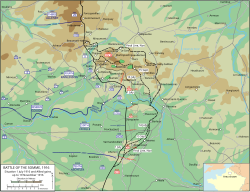
Back Bataille de la crête de Thiepval French Pertempuran Thiepval Ridge ID Battaglia del crinale di Thiepval Italian
| Battle of Thiepval Ridge | |||||||
|---|---|---|---|---|---|---|---|
| Part of The Battle of the Somme of the First World War | |||||||
 | |||||||
| |||||||
| Belligerents | |||||||
|
|
| ||||||
| Commanders and leaders | |||||||
|
Douglas Haig Hubert Gough Joseph Joffre Ferdinand Foch |
Crown Prince Rupprecht Max von Gallwitz Fritz von Below | ||||||
| Strength | |||||||
| 6 divisions | 3 divisions | ||||||
| Casualties and losses | |||||||
| 12,500 | 2,300–2,329 prisoners | ||||||
The Battle of Thiepval Ridge was the first large offensive of the Reserve Army (Lieutenant General Hubert Gough), during the Battle of the Somme on the Western Front during the First World War. The attack was intended to benefit from the Fourth Army attack in the Battle of Morval, by starting 24 hours afterwards.[a] The battle was fought on a front from Courcelette in the east, near the Albert–Bapaume road, to Thiepval and the Schwaben Redoubt (Schwaben-Feste) in the west, which overlooked the German defences further north in the Ancre valley, the rising ground towards Beaumont-Hamel and Serre beyond.
Thiepval Ridge was well fortified and the German defenders fought with great determination, while the British co-ordination of infantry and artillery declined after the first day, due to the confused nature of the fighting in the mazes of trenches, dugouts and shell-craters. The final British objectives were not reached until a reorganisation of the Reserve Army and the Battle of the Ancre Heights (1 October – 11 November). Organisational difficulties and deteriorating weather frustrated General Joseph Joffre's intention to proceed with vigorous co-ordinated attacks by the Anglo-French armies, which became disjointed and declined in effectiveness during late September, at the same time as a revival occurred in the German defence. The British experimented with new techniques in gas warfare, machine-gun bombardment and tank–infantry co-operation. The German defenders on the Somme front struggled to withstand the preponderance of men and material fielded by the Anglo–French, despite reorganisation and substantial reinforcement of troops, artillery and aircraft from Verdun. September became the month most costly in casualties for the German armies on the Somme.
Cite error: There are <ref group=lower-alpha> tags or {{efn}} templates on this page, but the references will not show without a {{reflist|group=lower-alpha}} template or {{notelist}} template (see the help page).
© MMXXIII Rich X Search. We shall prevail. All rights reserved. Rich X Search